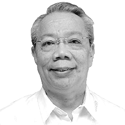
By Tony Samson
![people-holding-linkedin-icon-tablet-[rawpixel.com]](https://www.bworldonline.com/wp-content/uploads/2022/02/people-holding-linkedin-icon-tablet-rawpixel.com_.jpg)
IN the Van Gogh Museum three years ago, there was a special exhibit of the eponymous artist featuring his self-portraits, about 30 of them. The depictions were of various moods, mostly tortured and troubled, and none with a sunny disposition. This is to be expected of an artist so wracked with anxieties as to cut off one ear. And there is this famous Vincent self-portrait with a bandage on one ear.
Michelangelo in his Sistine Chapel painting of the Last Judgment placed a self-portrait of his in that much admired ceiling. He depicts himself as an old man clutching his own flayed skin waiting to be judged. It must have been the frustration of the work taking too long that made him think of his own death. Also, in his pique with his patron, Michelangelo also placed the pope among the souls burning in hell. So, self-portraits can drag along other personalities with them.
Self-descriptions are a facet of the digital age as well.
Dating sites on the internet are not known for their honesty in self-portrayal. Even the photos can be digitally altered. Generous characterizations of physical attributes are common. Someone describing herself as petite, almond-eyed, fair-skinned, and possessing a compelling ability to turn heads may in truth be drab and chubby (I never said I was slim), even shorter than a child actress. And claims of being a good conversationalist usually mean loving to hear one’s own voice, before the gong sounds.
Autobiography seldom works as objective history. The importance that even a principal player attaches to his role, say in controlling the excesses of martial law, is seen from a self-justifying point of view. Better to read a memoir which limits the role of the writer to an observer of others in a historical setting. The difference between the two forms of self-description has been proffered by a publisher. An autobiography describes how the lion feels as he walks through the open field. A memoir describes what the lion sees around him, including the presence of other predators.
In all self-portraits, there is the challenge of what events and details to include or exclude. The latter may be more important in the case of a shady past, like an occupation best left unmentioned such as the oldest profession after landscape gardening. (I did what I could to stave off hunger.) Even rags-to-riches stories have some gaps in the road to wealth and comfort. The shady corners of this narrative are best left in the dark.
CVs of job applicants are self-portraits that can take a fanciful turn. The line between receiving copies of a report and writing it is blurred. The team member of a task force evolves into its leader and catalyst — they didn’t even want to do it until I convinced them. Someone serving coffee can describe himself as a participant in a momentous meeting: there were loud voices in that room addressed to me — Can I have more cream, please?
We should not be too trusting of the merit of self-appropriated titles and declared competencies. Even calling cards may not be reliable. There are too many chiefs nowadays. So, is the Chief Future-proofing Officer just a meddler everyone ignores? The other “CFO” may have a weightier role.
Political self-portraits are now the stuff of electoral advertising. The paper windmill is one example of a symbol that seems to imply a Da Vinci type of invention by one candidate. The claim to being a proponent of renewable energy may be a little farfetched. But there it is.
Brand marketers that politicians use love to create “ownable” attributes. Aren’t candidates, after all, just products to be sold to the voting public? Does this deodorant make you smell like freshly laundered bedsheets? Or does it just stop perspiration, so there are no wet underarm spots when one raises his hands in a victory pose?
The smart phone now allows one to take one’s own photo. The resulting “selfie” (photographer and subject are one) is meant to be uploaded to the social page for friends to view and envy. Travel photos are favorites — I am standing in front of my mansion in San Francisco… without a face mask. (Is the house really his?)
Like the interviewee invited to talk about himself, there is the danger of inviting yawns by providing too much information…or doubts from giving out too little.
Tony Samson is chairman and CEO of TOUCH xda